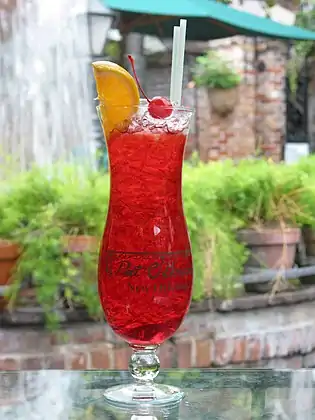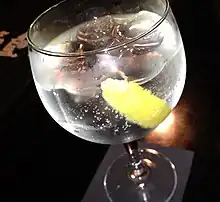| Cocktail | |
|---|---|
 A hurricane served in the typical glass at Pat O'Brien's, New Orleans | |
| Type | Cocktail |
| Base spirit | |
| Served | On the rocks: poured over ice |
| Standard drinkware | |
| Commonly used ingredients |
|
| Preparation | Shake ingredients with ice, then pour into the glass and serve over ice. |
| Notes | Some versions add orange juice, pineapple juice, and grenadine. Fassionola is also sometimes used in place of the passion fruit syrup. |
The hurricane cocktail is a sweet alcoholic drink made with rum, lemon juice, and either passion fruit syrup[1] or fassionola.[2][3][4] It is one of many popular drinks served in New Orleans. It is traditionally served in the tall, curvy eponymous hurricane glass. Disposable plastic cups are also used because New Orleans laws permit drinking in public and leaving a bar with a drink, but prohibit public drinking from glass containers.[5]
History
Currently the oldest known references to the hurricane cocktail date the drink's creation back to at least 1938. In 1939 in Queens, New York, it was served at the 1939-1940 New York World's fair at the "Hurricane Bar"[6] but it's unknown what ingredients were used to prepare the Hurricane drinks that were sold at the exhibition. The best representation of the original recipe and look of the Hurricane drink is depicted in the October- December 1938 produced/July 1939 released the Warner Bros. film Naughty But Nice, where the original hurricane drink appears to be simply lemonade or lemon juice with the addition of a generous portion of rum with little or nothing else added to it that would give it any appearance different from lemonade. The hurricane cocktail's similar appearance to ordinary lemonade plays a major role in the film's storyline which is about tee totaling Professor Donald Hardwick, (Dick Powell) who accidentally gets drunk from the cocktail in several scenes of the film due to the drink's identical look to the non-alcoholic lemonade he typically orders. The drink seen in the film does not have the now iconic red color typically found in hurricanes served today. The glass the hurricane is served in is a standard high ball glass instead of the iconic "hurricane lamp" shaped glasses used today. Within a few years after the film's release and the 1939-1940 World's Fair exhibition in New York ended different variations of the drink began to form.
The most popular association the hurricane cocktail has today is with the Pat O'Brien's chain of bars and restaurants, and particularly their original New Orleans location creation of the passion fruit-flavored relative of the daiquiri is credited to New Orleans tavern owner Pat O'Brien.[7] The bar allegedly started as a speakeasy called Mr. O'Brien's Club Tipperary and the password was "storm's brewin'".[7]
In the 1940s, O'Brien needed to create a new drink to help him get rid of all of the less-popular rum that local distributors forced him to buy before he could get a few cases of more popular liquors such as scotch and other whiskeys.[8][9] He poured the concoction into hurricane lamp–shaped glasses and gave it away to sailors. The drink caught on, and it has been a mainstay in the French Quarter ever since.
See also
References
- ↑ Berry, Jeff (2010). Beachbum Berry Remixed. San Diego: Club Tiki Press. p. 56.
- ↑ "Welcome Back, Fassionola: The Hurricane's Long Lost Ingredient". talesofthecocktail.com. 29 April 2016. Retrieved 19 August 2021.
- ↑ "Reclaiming the Hurricane". gardenandgun.com. Retrieved 19 August 2021.
- ↑ "Fassionola best Tiki ingredient". Foodandwine.com. Retrieved 19 August 2021.
- ↑ "French Quarter Frequently Asked Questions". Archived from the original on December 8, 2015. Retrieved December 11, 2015.
- ↑ "Rum Stories: The History of the Hurricane | Distiller".
- 1 2 Denise Gee (2007). Southern Cocktails: Dixie Drinks, Party Potions, and Classic Libations. p. 37. ISBN 978-0811852432.
- ↑ McNulty, Ian. "Drinking in History: Classic Cocktails and Modern Thirsts in the French Quarter". FrenchQuarter.com. Retrieved 2006-10-06.
- ↑ Lind, Angus. "Home of the 'Hurricane' Pat O'Brien's turns 75 this week". nola.com. Archived from the original on 2012-03-24. Retrieved 2009-06-19.
